An in-house assistant offers direct, immediate support with a deep understanding of company culture and day-to-day operations, enhancing team cohesion. A virtual assistant provides flexibility, cost-effectiveness, and access to specialized skills without the need for physical office space. Choosing between the two depends on the priority of personalized presence versus scalability and remote accessibility.
Table of Comparison
| Feature | In-house Assistant | Virtual Assistant |
|---|---|---|
| Location | On-site office | Remote, anywhere |
| Cost | High salary, benefits | Lower hourly or project-based fees |
| Flexibility | Fixed working hours | Flexible schedule |
| Skills | Limited to local talent pool | Diverse global expertise |
| Technology | Basic office tools | Advanced virtual communication tools |
| Scalability | Limited by office space and budget | Easily scalable team size |
| Supervision | Direct in-person management | Remote monitoring and reporting |
Understanding In-house Assistants and Virtual Assistants
In-house assistants are employees physically present within a company, providing direct support tailored to organizational culture and immediate needs. Virtual assistants operate remotely, leveraging digital tools to offer flexibility and cost-effectiveness across various administrative tasks. Understanding the distinctions between these roles helps businesses optimize resource allocation and enhance operational efficiency.
Key Differences Between In-house and Virtual Assistants
In-house assistants work on-site, offering direct interaction and immediate availability, while virtual assistants operate remotely, providing flexible support across various time zones. In-house assistants usually require fixed salaries and office space, whereas virtual assistants are typically contracted based on hours or tasks, reducing overhead costs. Virtual assistants often specialize in digital tools and multitasking across clients, whereas in-house assistants focus on company-specific tasks and culture integration.
Cost Comparison: In-house vs Virtual Assistants
In-house assistants require higher upfront expenses, including salaries, benefits, office space, and equipment, which can significantly increase operational costs. Virtual assistants, on the other hand, offer flexible pricing models, often billed hourly or per task, eliminating overhead costs and providing scalable support. Businesses can reduce expenses by up to 70% with virtual assistants while maintaining productivity and efficiency.
Recruitment and Onboarding Processes
In-house assistants require significant investment in recruitment, including extensive interviews and background checks, which extends the onboarding timeframe and increases costs. Virtual assistants streamline recruitment through specialized agencies or platforms that pre-qualify candidates, accelerating the hiring process and reducing administrative burden. Onboarding virtual assistants often leverages digital tools for remote training and integration, enhancing productivity while minimizing physical resource allocation.
Flexibility and Availability for Business Needs
In-house assistants offer limited flexibility due to fixed working hours and location constraints, restricting their availability to traditional office times. Virtual assistants provide greater adaptability with 24/7 availability and remote access, allowing businesses to scale support during peak periods or across different time zones. This flexibility ensures continuous operational efficiency and rapid response to dynamic business needs.
Data Security and Confidentiality Considerations
In-house assistants typically offer higher control over data security and confidentiality due to direct supervision and restricted access within the company's physical environment. Virtual assistants rely on secure cloud-based platforms, employing encryption and compliance with standards such as GDPR and HIPAA to protect sensitive information remotely. Organizations must evaluate the risk tolerance and regulatory requirements to determine which assistant model best safeguards their proprietary data and client confidentiality.
Communication and Collaboration Tools
In-house assistants leverage face-to-face interaction and direct communication channels, enabling immediate feedback and stronger team rapport, while virtual assistants depend on advanced collaboration tools such as Slack, Zoom, and Microsoft Teams to maintain seamless communication across remote locations. Virtual assistants utilize cloud-based project management platforms like Asana and Trello to synchronize workflows and ensure transparency in task progress, compensating for physical distance. The effectiveness of communication and collaboration tools significantly impacts productivity and team dynamics, making the choice between in-house and virtual assistants critical based on organizational needs.
Scalability: Adapting to Business Growth
In-house assistants often face limitations in scalability due to fixed working hours and the need for physical workspace, restricting their ability to adapt quickly to business growth. Virtual assistants provide flexible support that can be easily scaled up or down based on workload fluctuations, making them ideal for dynamic business environments. Cloud-based tools and remote collaboration enable virtual assistants to manage increased tasks efficiently without the overhead costs associated with expanding in-house teams.
Impact on Company Culture and Team Dynamics
In-house assistants foster stronger personal connections and immediate collaboration, enhancing company culture and team cohesion through daily face-to-face interactions. Virtual assistants offer flexibility and cost-efficiency but may challenge team dynamics due to limited physical presence and reliance on digital communication tools. Companies must balance these factors to maintain engagement while leveraging productivity benefits.
Choosing the Right Assistant for Your Business
Choosing the right assistant for your business depends on factors like budget, required expertise, and flexibility. In-house assistants offer direct oversight and immediate availability, ideal for businesses needing consistent, hands-on support. Virtual assistants provide cost-effective, scalable solutions with specialized skills, perfect for companies seeking remote help and diverse task management.
In-house Assistant vs Virtual Assistant Infographic

 bizdif.com
bizdif.com